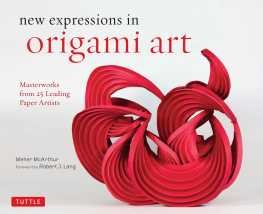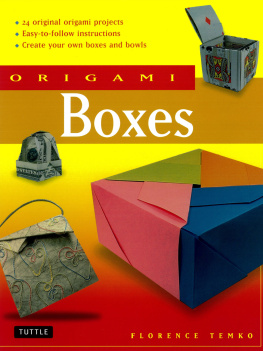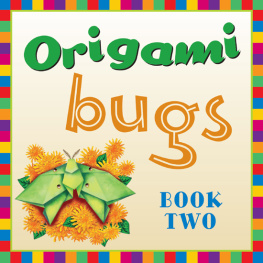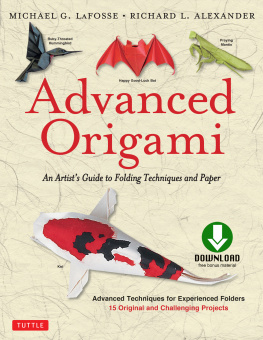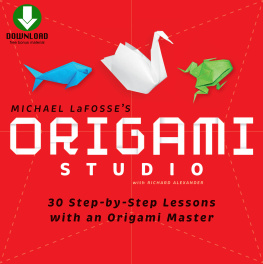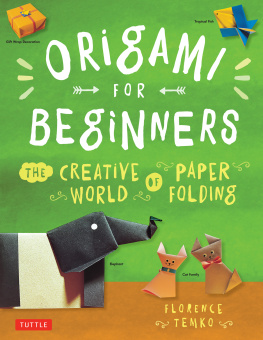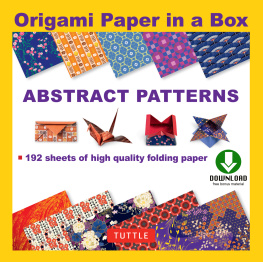Acknowledgments
I would like to thank Tuttle for their interest in a book about contemporary origami artists. As the world leader in publishing origami instructional books, they understand the level of interest in origami. I am also grateful to the staff of International Arts & Artists, who have championed exhibitions of origami art and supported this book in many ways. I am thankful to all of the artists featured in this book for generously answering my many questions, correcting my errors and contributing photographs of their work. I am also grateful to David Brill, Keiko Fukai and Alain Joisel for providing help with my essays about Tomoko Fuse, Yuko Nishimura and Eric Joisel, respectively, and to all of the photographers who allowed us to reproduce their images, in particular to Paulo Mulatinho and Silke Schrder for helping with images. I would also like to thank Robert J. Lang for his wisdom and encouragement during my exploration of the world of origami.
Thank you to my husband David and my son Theo for their support while I worked on this project. I dedicate this book to both of you.
ORIGAMI ART EXHIBITION CATALOGS AND FILM
Gould, Vanessa (director), Between the Folds , Green Fuse Films, NYC, 2012 (available through PBS.org)
Hangar-7, Salzburg (ed.), Masters of Origami at Hangar 7: The Art of Paperfolding , Ostfildern-Ruit, Germany: Hatje Cantz Verlag, 2005
McArthur, Meher and Robert J. Lang, Folding Paper: The Infinite Possibilities of Origami , Washington DC: International Arts & Artists, 2012 (Hardcover, Tuttle, 2013)
Mingei International Museum, Origami Masterworks: Innovative Forms in the Art of Paperfolding , San Diego: Mingei International Museum, 2003
ARTISTS WEBSITES AND BLOGS
Joel Cooper (USA)
joelcooper.wordpress.com
Erik Demaine and Martin Demaine (Canada/USA)
erikdemaine.org
martindemaine.org
Giang Dinh (Vietnam/USA)
giangdinh.com
Vincent Floderer (France)
le-crimp.org
Tomoko Fuse (Japan)
No artist website, but she is featured on David Brills blog: brilliantorigami.com/2015/09/16/freising-spacefolding/ and on Silke Schrder and Paulo Mulatinhos site: origami-galerie.de
Miri Golan (Israel)
foldingtogether.org
Paul Jackson (UK/Israel)
origami-artist.com
Beth Johnson (USA)
bethjohnsonorigami.com
Eric Joisel (France)
ericjoisel.com
Goran Konjevod (Croatia/USA)
organicorigami.com
Michael G. LaFosse and Richard L. Alexander (USA)
origamido.com
Robert J. Lang (USA)
langorigami.com
Sipho Mabona (South Africa/ Switzerland)
mabonaorigami.com
Mademoiselle Maurice (France)
mademoisellemaurice.com
Linda Tomoko Mihara (USA)
origamihara.com
Jun Mitani (Japan)
mitani.cs.tsukuba.ac.jp/en/
Jeannine Mosely (USA)
No artist website
Yuko Nishimura (Japan)
yukonishimura.com
Bernie Peyton (USA)
berniepeyton.com
Hoang Tien Quyet (Vietnam)
htquyet.origami.vn
Matt Shlian (USA)
mattshlian.com
Richard Sweeney (UK)
richardsweeney.co.uk
Jiangmei Wu (China/USA)
foldedlightart.com
of molecules and masks
THE TESSELLATED PORTRAITS OF JOEL COOPER

Photo by Jane Arajo
Since the year 2000 , a number of origami artists have been exploring the artistic potential of tessellation, a series of forms that are repeated to create a pattern that fills a plane with no gaps or overlaps. The term derives from the Latin word tessera , the name for the individual tiles used to make mosaics. In origami tessellations, pleats are used to connect molecules, such as twist folds, together in a repeating fashion. Japanese origami artist Shuzo Fujimoto first explored the technique systematically in the 1960s, leaving dozens of patterns that established the genre among origami enthusiasts. In the United States around the same time, artist and computer scientist Ron Resch also patented some tessellation patterns, but it took until the 1980s for his work to became known in the origami community. Now, origami artists throughout the world are using tessellation to create spectacular works of 2-D, relief and 3-D paper sculpture. Most of these are abstract and geometric in their patterning and formations. However, American artist Joel Cooper (b.1970) has discovered that he can employ the technique to create highly detailed and expressive masks portraying historical and imaginary figures.
Cooper was born in San Francisco but grew up in Kansas, where he lives today. When he was about eight years old he first became interested in origami, devouring the first book that his parents bought for him on the subject. Although he was also interested in math and science, he decided to major in Fine Arts at college, studying oil painting, bronze casting, stone carving, ceramics and other traditional media, while continuing origami as a hobby on the side. In 2000, many years after he graduated, he was browsing websites on geometry and discovered origami tessellations. As he investigated tessellation techniques, he found what had been missing for him in the traditional art forms he had studied at college. I could create art with geometry in a very direct way that I could not do with any other media, explains Cooper. Traditional origami may use geometry in an almost incidental way as a means to an end, but with origami tessellation the geometry is explicit. Using this technique, Cooper was able to bring together his love of origami, his fascination with geometry and his experience of sculpture to make a new art form that was uniquely his own.
While most artists who have been exploring this technique have focused on the seemingly infinite variety of geometric patterning possible through tessellation, Cooper saw the potential for modeling figures and faces in the systematic folding made up of pleats and twists. I found that manipulations of these shapes can create deformations in the plane of the paper, three-dimensional shapes, which is how I use origami to create these masks. In his sculptural technique, the key is transforming a surface rather than building a form from the inside out. For the past fifteen years, he has been experimenting with the technique, different types of paper and finishes to create a series of folded relief portraits that deceive the eye and confound the brain of most viewers. In his work entitled simply Mask (2010), a perfectly formed face of a young man or woman seems to push itself through what appears to be a woven green fiber surface. But in reality, the work is folded, not woven, from a single sheet of paper using a pleated tessellation pattern. By manipulating and modeling the central area and flattening out the plaits, Cooper formed the face in relief. The green finish and sheen of the paper lends it a patina that reminds us of ancient bronze sculptures, further tricking our brains into forgetting the piece is formed from paper.

Sargon
Joel Cooper, USA 2014, paper, metallic pigment, craquelure glaze, shellac ( Photo by the artist )

Caliban
Joel Cooper, USA 2014, elephant hide paper, shellac ( Photo by the artist )

Next page
